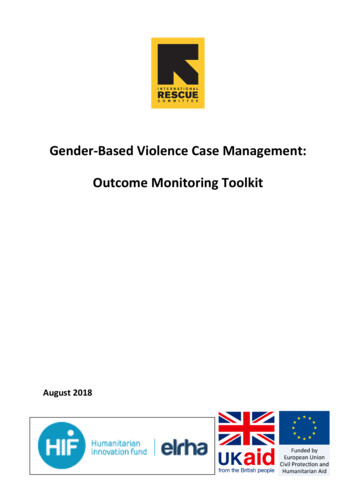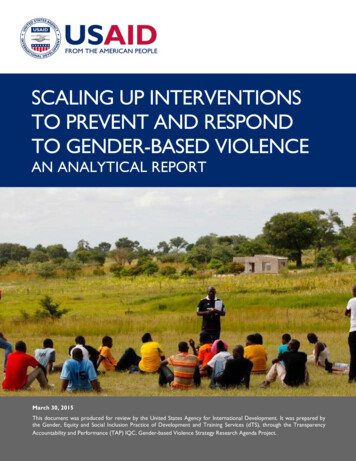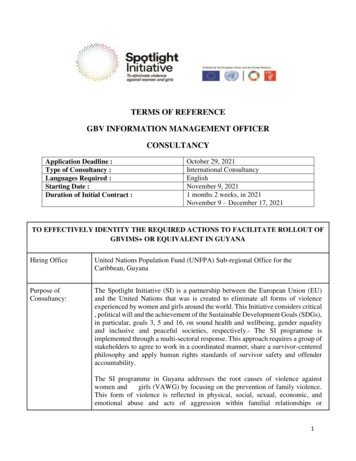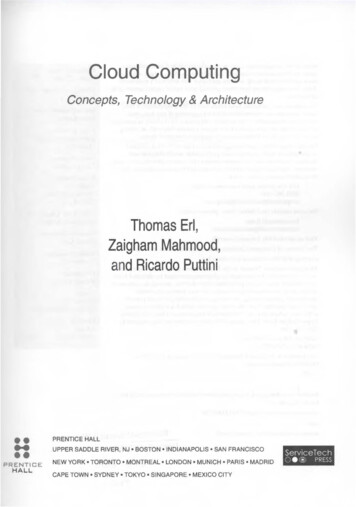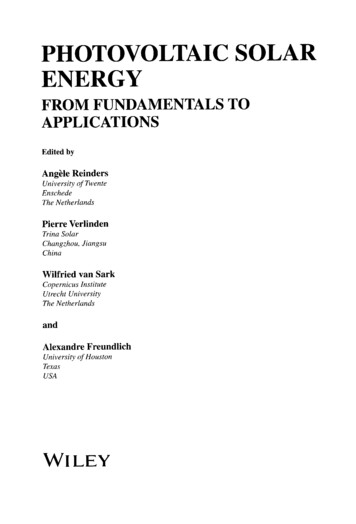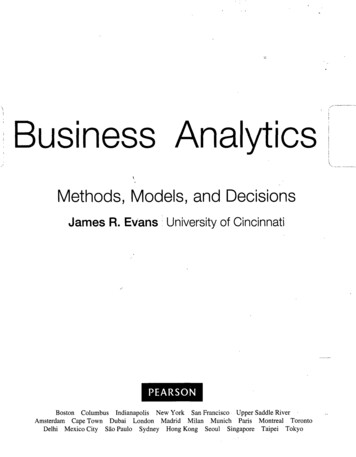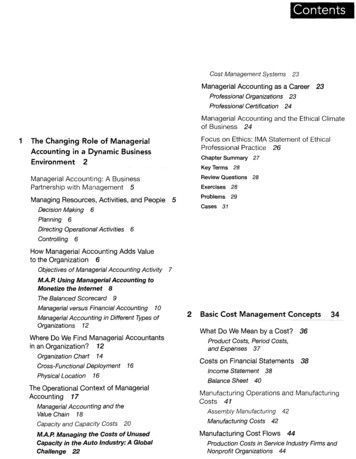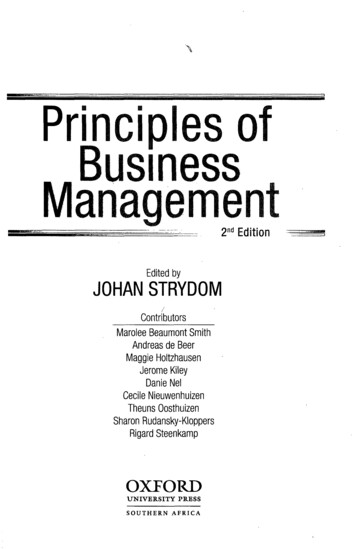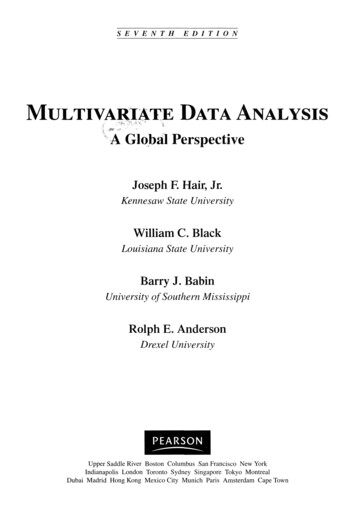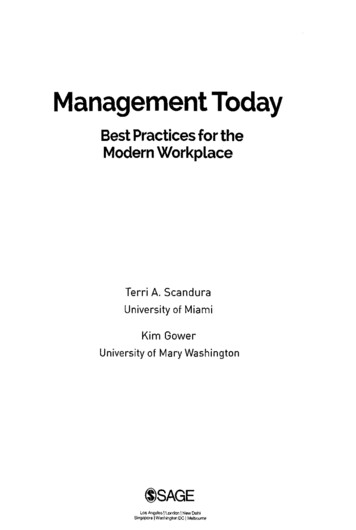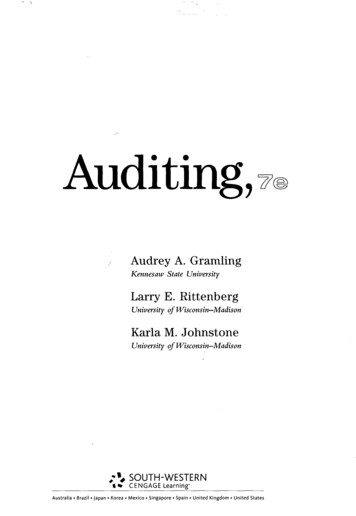
Transcription
AuditinAudrey A. GramlingKennesaw State UniversityLarry E. RittenbergUniversity of Wisconsin—MadisonKarla M. JohnstoneUniversity of Wisconsin—Madison/ % SOUTH-WESTERN*%CENGAGE Learning-Australia Brazil Japan Korea Mexico Singapore Spain United Kingdom United States
ContentsCHAPTER 1CHAPTER SAuditing: Integral to theEconomy, 2Corporate Governance and Audits, 36Importance of Audit Judgment, 2Increased Globalization of Accountingand Auditing, 5INTRODUCTION Auditing Defined, 6Auditing: A Special Function, 9Failures Within the Profession, 10The Need for Unbiased Reporting, 11Need for Assurance, 12CHANGES IN THE PROFESSION:INCREASED DEMAND FOR ACCOUNTABILITY, 13Demand for Improved Corporate Governance, 13Required Reporting on Internal Controls, 14Audit Standard Setting and AuditorIndependence, 15Public Expectations of Auditors, 15SCOPE OF SERVICES: OTHER ASSURANCE SERVICES, 15What Is Assurance?, 15REQUIREMENTS TO ENTER THE PUBLICACCOUNTING PROFESSION, 18Accounting and Auditing Expertise, 18Internal Control Expertise, 18Knowledge of Business and Its Risks, 19'Understanding Accounting System Complexity, 19THE PROVIDERS OF ASSURANCE SERVICES, 19The Public Accounting Profession, 19The Internal Audit Profession, 20The Governmental Auditing Profession, 21PROFESSIONAL AND REGULATORYORGANIZATIONS, 22The Public Company AccountingOversight Board, 22The Securities and Exchange Commission, 22The American Institute of Certified PublicAccountants, 23International Auditing and Assurance StandardsBoard, 23Committee of Sponsoring Organizations, 23Accounting Standard Setters, 24State Boards of Accountancy, 24The Institute of Internal Auditors, 24The U.S. Government Accountability Office, 24The Court System, 25All chapters contain the following end-of-chapter elements:SummarySignificant TermsSelected References to Relevant Professional GuidanceReview QuestionsMultiple-Choice QuestionsDiscussion and Research QuestionsCasesXIICORPORATE GOVERNANCEAND AUDITING, 38Corporate Governance Responsibilities and Failures, 39The Sarbanes-Oxley Act of 2002, 43Required Audit Firm Communication to theAudit Committee, 46Importance of Good Governance to the Audit, 47AUDIT STANDARD SETTING, 48Generally Accepted Auditing Standards and IAASBPrinciples, 51Fundamental Principles of IAASB AuditingStandards, 54Standards for Other Audit Engagements, 55Future of Audit Standard Setting, 56OVERVIEW OF THE AUDIT PROCESS:A STANDARDS-BASED APPROACH, 57Phase II: Understanding the Client, 58Phases III and IV: Obtaining Evidence, 60Phase V: Wrapping up the Audit and MakingReporting Decisions, 61FORD AND TOYOTA CASE 76CHAPTER 3Judgmental and EthicalDecision-Making Frameworksand Associated ProfessionalStandards, 78INTRODUCTION, 79Decision-Making, Ethics, and Organizational Performance, 79A GENERAL DECISION-MAKING FRAMEWORK, 80A Framework for Professional Decision-Making, 80AN ETHICAL DECISION-MAKINGFRAMEWORK, 82Accepting a Public Trust, 82Ethical Theories, 83An Ethical Framework, 84THE SARBANES-OXLEY ACT OF 2002 AS A REACTIONTO ETHICAL LAPSES, 86APPROACHES TO PROFESSIONALCODES OF ETHICS, 90International Ethics Standards Board for Accountants, 90AICPA Code of Professional Conduct, 90Independence Rules of the SEC and the PCAOB, 97FURTHER CONSIDERATIONS REGARDINGAUDITOR INDEPENDENCE, 98Major Threats to Independence, 99Managing Threats to Independence, 101Important Role of Audit Committees, 103FORD AND TOYOTA CASE 118
ContentsCHAPTER 4Audit Risk, Business Risk, andAudit Planning, 120NATURE OF RISK, 121MANAGING ENGAGEMENT RISK THROUGH CLIENTACCEPTANCE AND RETENTION DECISIONS, 124Management Integrity, 124Independence and Competence of the Audit Committee andBoard, 126Quality of Management's Risk Management Process and Controls, 126Regulatory and Reporting Requirements, 127Participation of Key Stakeholders, 127Existence of Related-Parry Transactions, 127The Financial Health of the Organization, 127Summary: High-Risk Audit Clients, 128The Purpose of an Engagement Letter, 129MANAGING AUDIT RISK, 130Materiality, 130Understanding the Audit Risk Model, 131PLANNING THE AUDIT USING THE AUDITRISK MODEL, 135Lessons Learned: The Lincoln Savings and Loan Case, 135Developing an Understanding of theBusiness and Risks, 137Understanding Management's Risk Management and ControlProcesses, 141Risk Analysis and the Conduct of the Audit, 142PRELIMINARY FINANCIAL STATEMENT REVIEW:USING ANALYTICAL TECHNIQUES TO IDENTIFYAREAS OF HEIGHTENED RISK, 144Assumptions Underlying Analytical Techniques, 144A Process for Performing Analytical Procedures, 145Types of Analytical Procedures, 146FORD AND TOYOTA CASEBILTRITE PRACTICE CASExiiiMake a Plan to Test the Controls and Execute That Plan, 219Consider the Results of Control Testing, 221DOCUMENTING THE AUDITOR'S UNDERSTANDINGAND ASSESSMENT OF AN ORGANIZATION'SINTERNAL CONTROLS, 222MANAGEMENT REPORTS ON INTERNAL CONTROLOVER FINANCIAL REPORTING, 223FORD AND TOYOTA CASE 249CHAPTER 6Performing an IntegratedAudit, 250EVOLUTION IN STANDARDS ON CONDUCTINGINTEGRATED AUDITS, 252AUDIT REPORTS ON INTERNAL CONTROL OVERFINANCIAL REPORTING, 253Unqualified Opinion on Internal Control over FinancialReporting, 253Adverse Audit Opinion on Internal Control over FinancialReporting, 253STEPS IN AN INTEGRATED AUDIT, 256Framework for Audit Evidence in an IntegratedAudit, 256Implementing the Integrated Audit Within the Audit OpinionFormulation Process, 257INTEGRATED AUDIT EXAMPLE: JUDGING THESEVERITY OF CONTROL DEFICIENCIES ANDIMPLICATIONS FOR THE FINANCIAL STATEMENTAUDIT, 270Management's Assessment of Controls, 271Auditor Assessment of Controls, 2727 701 73FORD AND TOYOTA CASE 290BILTRITE PRACTICE CASE 291CHAPTER SInternal Control overFinancial Reporting, 190IMPORTANCE OF INTERNAL CONTROL TO FINANCIALSTATEMENT AUDITS, 191COSO: A FRAMEWORK FOR INTERNAL CONTROL, 192Components of Internal Control, 193Risk Assessment, 195Control Environment, 197Control Activities, 200Information and Communication, 203Monitoring, 204Examples of Common Internal Control Activities, 204Common Control Activities, 205IT Controls Integrated intoInternal Control Evaluations, 206MANAGEMENT EVALUATION OF INTERNALCONTROLS, 212AUDITOR EVALUATION OF INTERNAL CONTROLS, 213Understand the Client's Internal Controls, 213Identify Controls to Test, 219CHAPTER 7Audit Evidence: A Framework, 304OVERVIEW OF THE AUDIT MODEL, 305ASSERTION MODEL FOR FINANCIAL STATEMENTAUDITS, 307GATHERING SUFFICIENT, APPROPRIATEEVIDENCE, 308Sufficiency, 310Reliability of Audit Evidence, 311Nature of Audit Testing, 314Audit Procedures, 315AUDIT PROGRAMS AND DOCUMENTING AUDITEVIDENCE, 321Audit Program Development, 321Documenting Audit Evidence, 322AUDITING ACCOUNT BALANCES AFFECTED BYMANAGEMENT'S ESTIMATES, 328Evidence Used in Auditing Management's Estimates, 329FORD AND TOYOTA CASE 347
xivContentsCHAPTER BTools to Gather Audit Evidence, 348OVERVIEW OF APPROACHES TO GATHERING ANDEVALUATING AUDIT EVIDENCE, 350Sampling: One Approach, 350Other Approaches, 351Overview of Audit Sampling, 352TESTING CONTROL EFFECTIVENESSA N D COMPLIANCE, 355Attribute Estimation Sampling, 356Nonstatistical Sampling, 365SAMPLING TO TEST FOR ACCOUNTBALANCE MISSTATEMENTS, 366Substantive Sampling Considerations, 366Nonstatistical Sampling, 369Monetary Unit Sampling (MUS), 370USING GENERALIZED AUDIT SOFTWARE T O PERFORMSUBSTANTIVE TESTS, 379Generalized Audit Software, 379ANALYTICAL PROCEDURES AS A SUBSTANTIVETEST, 383Assumptions Underlying Analytical Techniques, 383The Effectiveness of Substantive AnalyticalProcedures, 384Application of Analytical Procedures to SubstantiveTesting, 385Analytical Procedures Are Not Client Estimates, 385FORD AND TOYOTA CASE 404CHAPTER 9Auditing for Fraud, 408FRAUD A N D AUDITOR RESPONSIBILITIES:A HISTORICAL EVOLUTION, 409Magnitude of Fraud, 410Fraud Defined, 411Evolution of Fraud and Auditor Responsibility, 414Financial Reporting Frauds—The Second COSO Report, 417General Characteristics of Financial Reporting Frauds, 418AUDITING STANDARDS—MORE RESPONSIBILITY, 419A Proactive Approach to Fraud Detection, 420Conducting the Financial Statement Audit—FraudAwareness, 420FORENSIC ACCOUNTING, 443EXAMPLE: A N INTEGRATED AUDIT OF SALES A N DRECEIVABLES, 474Consider the Risk of Misstatement in the Revenue Cycle(Steps 1 and 2), 474Perform Preliminary Analytical Procedures (Step 3), 477Develop an Understanding ofInternal Controls (Step 4), 477Identify Important Controls (Step 5), 478Design and Perform Tests of Internal Controls and Analyze theResults of the Tests of Controls (Steps 6 and 7), 478Perform Substantive Tests (Step 8), 479PERFORMING THE INTEGRATED AUDIT OF THEREVENUE CYCLE, 479Consider the Risks Related to Revenue Recognition(Steps 1 and 2), 479Perform Preliminary Analytical Procedures (Step 3), 484Linking Internal Controls and Financial Statement Assertions forthe Revenue Account (Steps 4 and 5), 486Design and Perform Tests of Internal Controls and Analyze theResults of the Tests of Controls (Steps 6 and 7), 489Perform Substantive Tests in the Revenue Cycle (Step 8), 493FORD AND TOYOTA CASE 541BILTRITE PRACTICE CASE 542CHAPTER 11Audit of Acquisition and PaymentCycle and Inventory, 546INTRODUCTION, 547Significant Accounts and Relevant Assertions in the Acquisitionand Payment Cycle, 548PERFORMING THE INTEGRATED AUDIT OF THEACQUISITION A N D PAYMENT CYCLE, 549Consider the Risks Related to the Acquisition and PaymentCycle (Steps 1 and 2), 551Perform Preliminary Analytical Procedures for PossibleMisstatements (Step 3), 552Linking Internal Controls and Financial Statement Assertionsfor Accounts in the Payment and Acquisition Cycle (Steps 4. and 5), 552Design and Perform Tests of Controls and Analyze Results ofTests of Controls (Steps 6 and 7), 557Perform Substantive Testing of the Accounts in the Acquisitionand Payment Cycle (Step 8), 558COMPLEXITIES RELATED TO INVENTORY A N D COSTOF GOODS SOLD, 563Risks and Controls Related to Inventory and Cost of GoodsSold, 564Substantive Tests of Inventory and Cost of Goods Sold, 567FORD AND TOYOTA CASE 465FORD AND TOYOTA CASECHAPTER 1O-Auditing Revenue and RelatedAccounts, 466INTRODUCTION, 468The Cycle Approach, 468Overview of the Revenue Cycle, 469AUDITING INTERNAL CONTROLS A N DACCOUNT BALANCES—THE INTEGRATEDAUDIT OF REVENUE, 473Audit Stepsforan Integrated Audit, 473BILTRITE PRACTICE CASE598599CHAPTER 12Audit of Cash and Other LiquidAssets, 600INTRODUCTION, 601Overview of Cash Accounts, 601Overview of Financial Instruments and Marketable SecurityAccounts, 602Relevant Financial Statement Assertions, 603
ContentsINTEGRATED AUDIT OF CASH, 604Consider the Risks Related to Cash (Steps 1 and 2), 605Perform Preliminary Analytical Procedures toIdentify Possible Misstatements in the CashAccounts (Step 3), 607Identify .Typical Internal Controls over Cash(Steps 4 and 5), 607Design and Perform Tests of Controls and Analyze Results ofTests of Controls (Steps 6 and 7), 615Perform Substantive Testing of Cash Balances(Step 8), 617COMPLEXITIES RELATED TO THE AUDITOF MARKETABLE SECURITIES A N D FINANCIALINSTRUMENTS, 623Introduction, 623Audits of Commercial Paper, 624Audits of Investments in Equity and Debt Securities, 624Audits of Derivative Instruments, 626Audits of Financial Hedges, 629FORD AND TOYOTA CASE 650BILTRITE PRACTICE CASE 651CHAPTER 13Audit of Long-Lived Assets andRelated Expense Accounts, 654INTRODUCTION, 655Significant Accounts and Relevant Assertions in the Long-LivedAsset Cycle, 655PERFORMING THE INTEGRATED AUDIT OF LONGLIVED ASSETS A N D RELATED EXPENSES, 656Consider the Risks Related to Long-Lived Assets (Steps 1and 2), 657Perform Preliminary Analytical Procedures for PossibleMisstatements (Step 3), 659Linking Internal Controls and Financial Statement Assertions forLong-Lived Assets and Related Expenses (Steps 4 and 5), 660Design and Perform Tests of Controls and Analyze Results ofTests of Controls (Steps 6 and 7), 661Perform Substantive Testing of the Long-Lived Assets andRelated Accounts (Step 8), 662SPECIAL TOPICS, 672Intangible Assets and Natural Resources, 672Leases, 673FORD AND TOYOTA CASE 688BILTRITE PRACTICE CASE 689CHAPTER 14Audit of Long-Term Liabilities,Equity, Acquisitions, and RelatedEntity Transactions, 690INTRODUCTION: BUSINESS RISK A N D SUBJECnVEJUDGMENTS, 692LONG-TERM LIABILITIES A N D OWNERS' EQUITY, 692Long-Term Liabilities with Significant SubjectiveJudgments, 692Bonds and Stockholders' Equity, 694xvMERGERS AND ACQUISITIONS, 699Acquisition—Asset Valuation Issues, 700Audit Procedures for Restructuring Charges and GoodwillImpairment, 702TRANSACTIONS WITH RELATED ENTITIES, 707Accounting for Transactions with Related Entities, 708Related-Entity Transactions and Small Businesses, 708Audit ApproachforRelated-Entity Transactions, 708Variable Interest Entities, 711Disclosure of Other Significant Relationships, 712FORD AND TOYOTA CASE 729BILTRITE PRACTICE CASE 730CHAPTER 15Completing the Audit, 734AUDIT QUALITY A N D COMPLETING THE AUDIT, 735Evaluating the Going-Concern Assumption, 736Evaluating Management Representations, 740Summarizing and Resolving PossibleAdjustments, 741Reviewing Contingencies, 745Reviewing Significant Estimates, 746Evaluating Adequacy of Disclosures, 748Performing Analytical Review of the Audit and FinancialStatements, 749Performing an Engagement Quality Review, 750Communicating with Management via the ManagementLetter, 751Communicating with the Audit Committee, 752Assessing Subsequent Events, 753FORD AND TOYOTA CASE 771BILTRITE PRACTICE CASE 772CHAPTER 16Auditors' Reports, 774LEVELS OF ASSURANCE PROVIDED BYAUDITORS, 776A U D I T R E P O R T S O N FINANCIAL STATEMENTSA N D I N T E R N A L C O N T R O L OVER FINANCIALR E P O R T I N G , 776Reporting on Internal Control overFinancial Reporting, 777EXPRESSION OF A N OPINION O N THE FINANCIALSTATEMENTS, 778Standard Unqualified Audit Report, 779Modifications to the Standard Unqualified Report NotAffecting the Opinion, 780Modifications to the Standard Unqualified Report Affecting theOpinion, 783Audit Reports on Comparative Statements, 788Summary of Audit Report Modifications, 789OTHER REPORTS RELATED TO FINANCIALSTATEMENT INFORMATION, 789Reviews and Compilations forNonpublic Companies, 789Reviews of Interim Financial Information for PublicCompanies, 795Special Reports, 798
ContentsXVIATTESTING TO OTHER INFORMATION PROVIDED BYMANAGEMENT, 802Attestation Example: Attesting to Financial Reporting UsingXBRL, 802Agreed-Upon Procedures, 803Prospective Financial Statements, 803Pro Forma Financial Information, 803Compliance Attestation, 804FORD AND TOYOTA CASE 825BILTRITE PRACTICE CASE 826CHAPTER 17Professional Liability, 828THE LEGAL ENVIRONMENT, 829Liability Doctrines, 830Audit Time and Fee Pressures, 831Audits Viewed as an Insurance Policy, 831Contingent-Fee CompensationforLawyers, 831Class Action Suits, 832BASIC LEGAL CONCEPTS, 832Causes of Legal Action, 833Parties That May Bring Suit Against Auditors, 834LEGAL PRECEDENCE: LIABILITY TO CLIENTS A N DTHIRD PARTIES U N D E R COMMON LAW A N DSTATUTORY LAW, 834Common-Law Liability to Clients—Breach of Contract, 834Common-Law Liability to Third Parties, 836Statutory Liability to Third Parties, 838Liability Issues of Multinational CPA Firms, 842Liability Impact of Internet Dissemination of Audited FinancialInformation, 842Liability: Always a Changing Landscape, 843Summary of Auditor Liability to Third Parties, 843MINIMIZING LIABILITY EXPOSURE, 843Policies to Help Assure Auditor Independence, 843Quality-Control Programs, 844Review Programs, 845Continuing Education Requirement, 846Defensive Auditing, 846CHAPTER 18Advanced Topics ConcerningComplex Auditing Judgments, 862COMPLEX AUDIT JUDGMENTS, 863MATERIALITY JUDGMENTS, 866Purpose of Materiality Judgments and Common Benchmarksand Thresholds, 866Common Difficulties in Making Materiality Judgments, 869ASSESSING WHETHER MISSTATEMENTS AREMATERIAL, 871Aggregating and Netting Misstatements, 871Evaluating Uncorrected Misstatements, 871Subjective Differences Between theAuditor and Client, 872Recent Regulatory Changes Concerning MaterialityJudgments, 872Intentional Misstatements, 873Misstatements in the Statement of Cash Flows, 873Known vs. Projected Misstatements, 873CONCLUSIONS ABOUT INTERNALCONTROL DEFICIENCIES, 874Nature of Material Weaknesses in Internal Control, 874Critical Criteria in Assessing Materiality of Internal ControlWeaknesses, 875EVALUATING A CLIENT'S INTERNALAUDIT FUNCTION, 877Internal Auditing Contrasted with External Auditing, 878Staffing an Internal Audit Function, 879Evaluating the Quality of Client's Internal Audit Function, 879Effect of Internal Audits Work on the External Audit, 881AUDITING FAIRVALUE ESTIMATES, 881THE ACCOUNTING MODEL FORFAIR VALUE ESTIMATES, 882ISSUES IN AUDITING ADJUSTMENTS TO FAIR MARKETA N D IMPAIRMENTS, 883Fair Value Estimates, 884Impairments, 885FORD AND TOYOTA CASE 905ACL APPENDIXACL Basics, Tutorial, and Cases, 906Data Files, 906Getting Started, 906ACL BASICS, 906(1) Create a New Project, 906(2) Open an Existing Project, 907Basic Activities, 907Sampling—Size, Selection, Evaluation, 909Saving Files, 910Sort, 910Stratify, 910Summarize, 910Verify, 911Views, 911Delete Files, 911Close Projects, 911ACL TUTORIAL, 911StartUp, 911Husky Tutorial Case, 911ACL CASE 1—FRAUD, 928ACL CASE 2—BENFORD'S LAW CASE, 929Using ACL to Perform Benford Analysis, 929The Case, 929I N T R D D U C T I O N T O ACL CASES 3 AND 4—ACCOUNTSRECEIVABLE AND INVENTORY; 930ACL CASE 3—ACCOUNTS RECEIVABLE, 930Audit Program, 931ACL CASE 4—INVENTORY, 931Case Index, 933Index, 934
USING GENERALIZED AUDIT SOFTWARE TO PERFORM SUBSTANTIVE TESTS, 379 Generalized Audit Software, 379 ANALYTICAL PROCEDURES AS A SUBSTANTIVE TEST, 383 Assumptions Underlying Analytical Techniques, 383 The Effectiveness of Substantive Analytical Procedures, 384 Application of Analytical Procedures to Substantive Testing, 385
